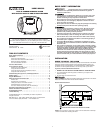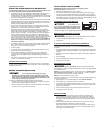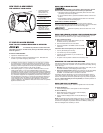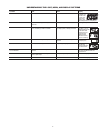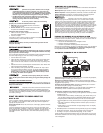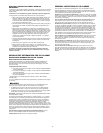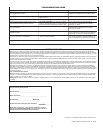
2
INSTALLATION, Continued
WHERE THIS ALARM SHOULD NOT BE INSTALLED
T
o avoid causing damage to the unit, to provide optimum protection, and
to pr
event unnecessary alarms, Do NOT locate this Alarm:
•
In garages, kitchens, crawl spaces and unfinished attics. Avoid extremely
dusty, dirty or greasy areas. Installation in these areas could lead to
nuisance alarms, may expose the sensor to substances that could damage
or contaminate it, or the Alarm may not be hear
d by persons in other areas
of the home, especially if they are sleeping.
•
In the garage, vehicle exhaust can contain some carbon monoxide. These
levels ar
e higher when the engine is first started. Within hours of starting a
vehicle and backing it out of the garage, the levels present over time can
activate the Alarm and become a nuisance.
• In the kitchen, some gas appliances can emit a short burst of CO upon
start-up. This is normal. If your CO Alarm is installed too close to these
appliances, it may alarm often and become a nuisance.
• Keep units at least 20 feet (6 meters) from the sources of combustion
particles (stove, fur
nace, water heater, space heater) if possible. In areas
wher
e a 20-foot (6m) distance is not possible – in modular, mobile, or
smaller homes, for example – it is recommended the Alarm be placed as
far fr
om these fuel-burning sources as possible. The placement recom-
mendations ar
e intended to keep these Alarms at a reasonable distance
from a fuel-burning source, and thus reduce “unwanted” alarms. Unwanted
alarms can occur if an Alarm is placed dir
ectly next to a fuel-burning
sour
ce. Ventilate these areas as much as possible.
If you must install the
Alarm near a cooking or heating appliance, install at least 5 feet (1.5
meters) fr
om appliance.
• In extremely humid areas. This Alarm should be at least 10 feet (3 meters)
fr
om a shower, sauna, humidifier, vaporizer, dishwasher, laundry room,
utility r
oom, or other sour
ce of high humidity.
•
In direct sunlight.
• In turbulent air, like near ceiling fans or open windows. Blowing air may
prevent CO from reaching the sensors.
•
In areas where temperature is colder than 40˚ F (4˚ C) or hotter than
100˚ F (38˚ C). These ar
eas include non-airconditioned crawl spaces,
unfinished attics, uninsulated or poorly insulated ceilings, porches, and
garages.
• Less than 12 inches (305 mm) away from fluorescent lights. Electrical
“noise” can interfere with the sensor.
AVOIDING DEAD AIR SPACES
“Dead air” spaces may prevent CO from reaching the Alarm. To avoid dead
air spaces, stay at least 4 inches (102 mm) away from corners where walls or
ceilings and walls meet.
HOW TO INSTALL THIS CO ALARM
IMPORTANT! Read all instructions before using this product.
T
ools you will need:
Scr
ewdriver, drill.
1.
Determine the best location for your CO Alarm.
2. Your Alarm is equipped to be mounted as a corded unit or a direct plug
unit. The unit can be plugged dir
ectly into a wall outlet. If your outlets are
mounted horizontally
, refer to “If Outlet is Mounted Horizontally (Sideways)”.
If the adapter is taken out of the unit, the Alarm can be installed high on the
wall, while the adapter is plugged into a wall outlet.
ACTIV
ATING THE BATTERY BACK-UP
Activate the battery back-up by installing the two
(2) AA batteries. The batter
y is for back-up only
and is not intended to power the Alar
m for an
extended period of time in the absence of AC.
The Alarm will light-up the display briefly to indicate the unit is r
eceiving power.
DIRECT PLUG ALARM INTO AN OUTLET
This Alarm can be plugged dir
ectly into a wall outlet located close to the floor.
1.
Choose a standard UNSWITCHED 120V AC outlet.
2.
Plug Alarm in.
IF OUTLET IS MOUNTED HORIZONTALLY (SIDEWAYS)
If you are going to use your Alarm as a direct plug into an outlet that is
mounted horizontally (sideways), you may want to r
otate the adapter 90º,
as follows:
1.
With back of unit facing you (AC blades on your left), place your left thumb
on adapter release and grab AC blades with your right hand to release the
left side.
2. Repeat for the other side adapter thumb release. This will allow adapter to
slide out.
3.
Remove adapter.
4. Rotate the adapter 90º and snap firmly back into place.
5. Plug Alarm into AC outlet.
WALL MOUNTED ALARM
Installation tips for power cord models: The power cord option provides
more flexibility in mounting locations and allows the Alarm to be easily installed
at or above eye level.
NOTE: If you mount the Alarm high on a wall, make sure it is at least 4 inches
(102 mm) down from the ceiling. Any higher than this, it will be in “dead air”
space and carbon monoxide may not reach the sensor.
NOTE: Do not cover the Alarm with a curtain.
To install for a wall-mount, you will need to pull out the removable adapter and
power cord, as follows:
1. Repeat steps 1 to 3 as described above in
“to rotate the adapter”.
2. With adapter out, pull out power cord and unwrap it.
3. Insert the screws provided until head is approx. 1/8 inch (3 mm) from wall
(if mounting in plaster boar
d or drywall, drill 3/16 inch (5 mm) hole and use
plastic anchor pr
ovided).
4. Hook the Alarm over the screw onto the keyhole in back of unit.
5. Plug power cord into AC outlet.
BEFORE YOU BEGIN INSTALLATION
• Make sure the alarm is not receiving excessively noisy power.
Examples of noisy power could be major appliances on the same
circuit, power from a generator or solar power, light dimmer on the
same circuit or mounted near fluorescent lighting. Excessively noisy
power may cause damage to your Alarm.
Find the pair of self-adhesive labels included with this CO Alarm.
•
On each label write in the phone number of your emergency responder
(like 911) and a qualified appliance technician.
• Place one label near the CO Alarm, and the other label in the “fresh air”
location you plan to go if the alarm sounds.
TEST THE ALARM
1.
Make sure the Alarm is receiving AC power. Under normal operation, the
Green indicator light will shine continuously.
If the Green power indicator
light does not light, recheck connections. If connections are correct and
the Gr
een power indicator still does not light, the unit should be r
eplaced
immediately.
2. Press and hold the test button until the alarm sounds. You will hear the
signal that indicates the presence of carbon monoxide.
When testing the Alarm, have someone else check that the Alarm can be
heard easily from the sleeping areas. The unit should be located where it
can wake you if it alarms at night.



